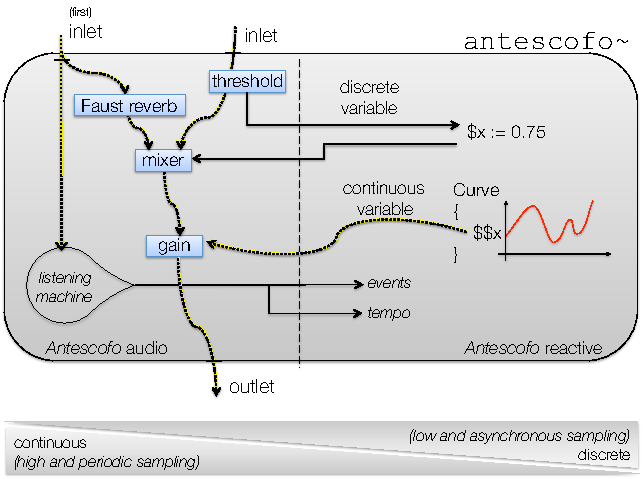Section: New Results
Embedding real-time audio computation in Antescofo
DSP processing in Antescofo is an experimental extension of the language started in 2014 and aimed at driving various DSP processing capabilities directly within Antescofo. DSP processors are defined directly in an Antescofo score, harnessing various signal processing libraries. These DSP processors are then dynamically connected together using Antescofo audio links. Input and output channels are used to link these processors with the host environment while internal channels connect DSP among themselves. The connections are specified with a new kind of Antescofo actions, the patch. So, the connections can be changed dynamically in response to the events detected by the listening machine and can be synchronized using the expressive repertoire of synchronization strategies available in Antescofo. Ordinary Antescofo variables can be used to control the DSP computations, which add an additional level of dynamicity. Currently, FAUST and and a few specific signal processors (notably FFT) can be defined. Several benefits results of this tight integration. The network of signal processors is heterogeneous, mixing DSP nodes specified with different tools. The network of signal processors can change dynamically in time following the result of a computation. This approach answers the shortcomings of fixed (static) dataflow models of the Max or PureData host environments. Signal processing is controlled at a symbolic level and can be guided, e.g. by information available in the augmented score (like position, expected tempo, etc.). The tight integration makes possible to specify, concisely and more effectively, finer and more precise control of the signal processing, at a lower computational cost. One example is the use of symbolic curve specification to specify variations of control parameters at sample rate. It makes it possible to embed sound analysis inside Antescofo as well. At last but not least, signal processing can be done more efficiently. For example, in the remaking of Boulez' piece Antheme 2 there is an improvment of performance in time of 45 % compared to the original version with the audio effects managed in Max.
The current work focuses on the development of a dedicated type system enabling a finer control of scheduling and audio buffer size, refining results previously developped in the cyclostatic scheduling of synchronous dataflow. Early results are published in [29] .


